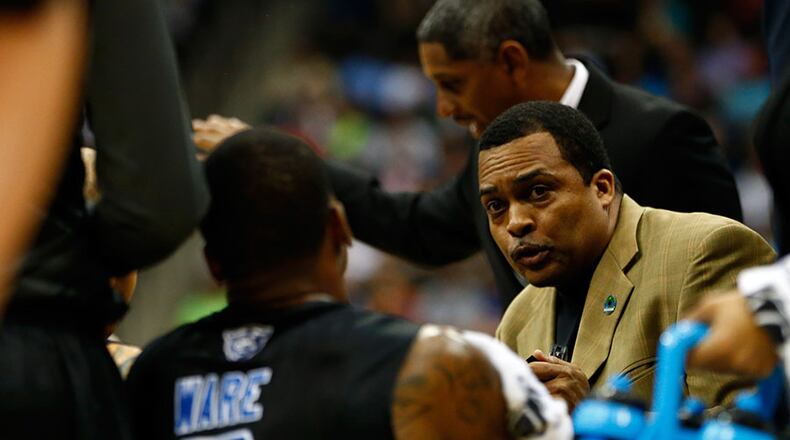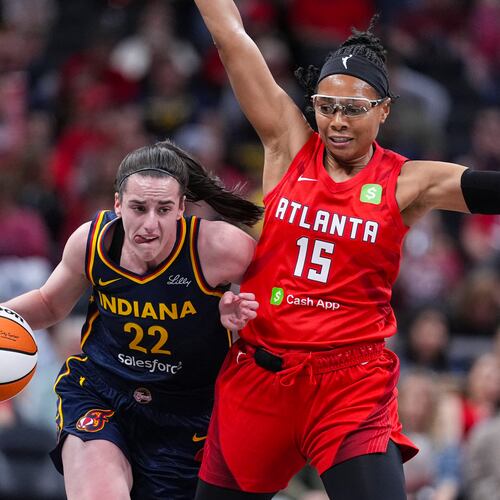This probably isn’t a fair comparison because Georgia State has been playing basketball since 1963 and didn’t field its first football team until 2010 (and then opted to do a cannonball into the deep end of Division I after only three seasons).
But the Panthers’ success in basketball, with two straight Sun Belt regular season titles, an inspiring run in the NCAA tournament and a significant increase in fan support, reaffirms something I’ve long believed: Basketball, not football, is where the school needs to make its mark.
Basketball, not football, has long been a more realistic endeavor. Basketball, not football, is far more manageable in terms of expense and personnel required. If done correctly, it can quickly make a significant impact on campus, in the community and sometimes even on SportsCenter.
There is no way to quantify yet what Georgia State’s season and the stories surrounding Ron Hunter and his son R.J. will mean to the school. But Hunter’s torn Achilles (suffered after the Panthers won the Sun Belt tournament) and his use of a rolling chair to coach on the sideline was publicity gold for the school. Also comedy gold.
“You can’t buy the kind of publicity we’ve had recently,” athletic director Charlie Cobb said Tuesday. “I think what this weekend showed is we can win and there’s a window now for us to garner mass attention. The day-to-day attention is what we’re after.”
It’s logical for any athletic director to think that way. I’m just not sure similar success will evolve in football.
Nobody has to convince me what a successful football program can do for a university. I live in here, in the South, in the heart of the college football nation. But football has been a slippery slope for State. I never really sensed an overwhelming need for it or desire for it. The costs are enormous and progress would come slow, if at all.
Trent Miles seems like a solid football coach. I have little doubt he is capable of winning at Georgia State, as he did at Indiana State, assuming he can start to get some players to go there. But there are issues even more daunting than Miles improving on his 1-23 record: 1) Expense; 2) Poor fan support.
According to the Department of Education’s equity in athletics database, GSU lists operating (game day) expenses of $526,542 for men’s basketball and $2,081,017 for football. Total expenses are $1,968,343 for men’s basketball and $6,132,435 for football. Basketball supports three coaches and 16 “participants,” football nine coaches and 155 “participants.” Data is for the reporting year ending in June of 2014.
Athletic department expenses will rise, particularly in football, as the NCAA responds to criticism and litigation with increased value of scholarships.
The total revenues on the DOE’s report zero out the budget. But Cobb acknowledges that can be misleading because money can be shifted over from the total budget. In other words, football alone may not be generating more than $6 million in revenue through ticket sales, etc.
Small crowds for football home games suggest gate revenue is a major issue. The Panthers, like other smaller programs, supplement that by “selling” games to major programs (Alabama, West Virginia, Washington, Clemson) that they know will result in lopsided losses.
Question: Is that a way to survive?
Cobb, who has been on the job for six months, said he has not studied specific revenue losses or gains in particular sports. But he said, “Clearly, there are some investments we need to make” in basketball to appease Hunter.
Those investments include: raises for him and his assistants; building a somewhat temporary practice facility in a space adjacent to the GSU arena and aquatics center, at a cost of $1 million to $1.5 million (this would fulfill a need until fund-raising is completed for a more ambitious $10 million sports performance center); a commitment to fly charters to some games in lieu of busing or commercial flights; upgrades in the school’s antiquated arena that include a video board and increased office space.
State also continues to invest in football, with a $1 million weight and training area at the off-campus practice facility, and Cobb continues to believe the school can succeed in football.
Several mid-majors, Wichita State, Butler and Xavier among them, have either dropped football or compete at the FCS level, to focus on hoops. But Cobb insists State can succeed in both.
“Many do it and some do it in a pretty positive way,” he said.
Time frame?
“Everybody recognizes that to build a sustainable and competitive football program, you’re probably looking at a 10-year window. So if we’re struggling five years into it, it’s not a surprise.”
The jury remains out on football. The verdict is in on basketball.
About the Author
Keep Reading
The Latest
Featured


